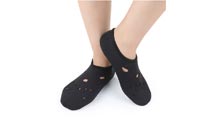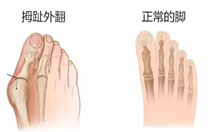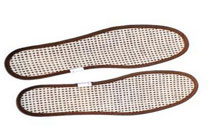With the improvement of the quality of life, people's awareness of foot care and health care is increasing. The "insole", a small item which was easily ignored before, is gradually coming into people's vision. Sweat absorption, breathability, durable, foot-shaped comfortable insoles are more and more popular, together with a large number of sports shoes, travelling shoes and casual shoes on the market every year. The market capacity of high-quality and comfortable insoles will be enormous because of the wear and tear of the insoles. In Europe and the United States, more than 50% of people use modern technology to prepare comfortable insoles, especially in the foot care industry in the United States, and insoles occupy half of the market share.
First, what are the functions of insoles?
1. The insole can prevent the foot from sliding in the shoe. The shoe bed inside the shoe is flat, but the sole of the foot is not, so when walking, the sole of the foot will slide in the shoe, and each step will take a little more effort, so the long-distance walking is easy to cause all kinds of trauma. However, the use of three-dimensional insoles can fill the space between the sole and the shoe bed to prevent the sole from sliding in the shoe.
2. The insole can provide foot support and improve the stability of footsteps. The heel-wrapped insole can reduce the swing of heel-to-ground while walking, stabilize the heel and keep the root bone neutral, thereby reducing fatigue and foot strain.
3. Shoe insoles can absorb and reduce shock. There are two ways, one is to use a hard cup-shaped heel bracket or shock absorber. The hypertrophic muscle of human heel is a natural shock absorber and shock reducer, as long as it is matched with a suitable radian of hard rubber bracket or the shock absorber. It can play a good function of shock absorption and reduction. The other is the use of soft materials, such as GEL, air cushion, etc. to absorb the impact of foot landing, which is suitable for running, basketball and other high-jump movements.
4. The insoles can correct walking and standing posture. This is the function of orthopaedic insoles. Many people, due to natural and other factors, do not have 100% vertical spine and leg bones when standing, or swing when walking left and right. For a long time, it will cause various kinds of bone and joint injuries. With the help of orthotic insoles, the posture of walking and standing can be corrected, so as to reduce the trauma.
Second, the classification of insoles
According to the current market insole material, it can be roughly divided into several major varieties: cotton insole, pure natural materials such insoles made of as hemp, rattan, grass, paper, leather insoles, GEL insoles, EVA insoles, high polymer breathable cotton insoles and PU insoles.
1. Traditional cotton insoles. It is made of the pure new cotton material processed, which should be classified as environmental protection insoles. The advantages: It has the good air permeability, can absorb part of the odor, has non-toxic side effects on the skin. Disadvantages: poor plasticity, no sweat absorption, easy deformation. In the course of walking, people often slip or flee out of shoes, which increases the wearer's worry. For people with sweaty feet, because of poor sweat absorption, the whole shoe is like a going through a rainstorm on the loess heap, which is muddy and painful. At the same time, it does not have the function of deodorizing.
In addition, most of these insoles are manufactured in handicraft workshops or simple factories, and most of the raw materials come from recycled waste clothes, hospitals, hotels, polluted and worn bedsheets and quilts, industrial leftovers, blankets processed with black cotton, etc. This kind of insole material is usually made without any disinfection and sterilization, and the surface is covered with a new layer of fabric. The bacterial content of such insoles is seriously over the standard, and it is an important source of transmission of foot gas infection, which is called rubbish insoles by relevant departments.
2. Insoles made of pure natural environmental protection materials, such as hemp, rattan, straw, paper, etc. Advantages: The material is natural and environmental friendly, and has some antimicrobial effects, good air permeability. Disadvantage: Because the workmanship is difficult to refine, it affects the comfort and beauty. There are also shortcomings of easy sliding in shoes.
3. Leather insole (imitation leather insole). Advantages: Comfortable and elegant, suitable for people with less sweating feet. Disadvantage: Leather of dermal insole will become stiff after aging, and dermal insole will only absorb odor and will not deodorize, with poor hygroscopicity. Therefore, it is not suitable for those with sweating feet and stinky feet.
In addition: this kind of insole leather is usually processed by tanning and coloring. It is mainly made up of pigskin lining leather, two layers of cattle and three layers of cattle, and Leather-like insoles are mostly made through crushed ballast, crushed glued and pressed process. Leather-like insoles have poor air permeability. Inhalation of foot sweat will discolor and pollute socks or upper lining.
4. GEL elastomeric insole (silica gel insole). The GEL elastomer has the advantages of super shock absorption, excellent cushioning and lasting comfort, avoiding the pain and fatigue of feet and joints during walking and exercise, reducing the concussion of spine and hindbrain, which is suitable for people who often walk and exercise. Disadvantage: poor air permeability.
5. EVA insoles. Vinyl acetate copolymer is a kind of polymer material. Advantages: light weight, good elasticity, good flexibility, not easy wrinkling, which is suitable for various climates. Disadvantages: poor permeability and poor long-term resilience, but high elasticity EVA can solve such problems.
6. Environmental-friendly high-polymer breathable cotton insole, represented by "Haipoli". It is called the high-poly in English form, which is also known as "Polyyou". The main ingredient is polyurethane, which has good permeability, super water absorption, excellent deformation resistance, good odor-proof effect, as well as shock absorption and rebound function, consistent with the ground retention and the stress change of the foot in time, especially the long-term and high-intensity sports, which is the ideal insole material for all kinds of brand sports and leisure shoes.
7. PU insole. Polyurethane synthetic materials. Advantages: high density, high hardness, toughness, wear resistance, good elasticity, no easy wrinkling, which is mostly for the sole of shoes. Disadvantages: yellowing, poor elongation, poor air permeability.
Dongguan Zhiguo is a
shoe insole supplier. Welcome to choose and buy them.


